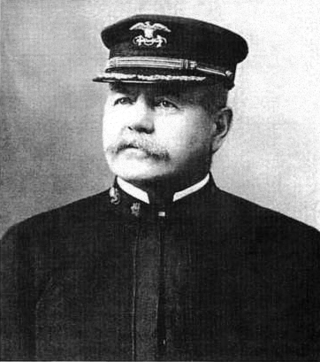
The United States Coast Guard (USCG) is the maritime security, search and rescue, and law enforcement service branch of the United States Armed Forces and one of the country's eight uniformed services. The service is a maritime, military, multi-mission service unique among the United States military branches for having a maritime law enforcement mission with jurisdiction in both domestic and international waters and a federal regulatory agency mission as part of its duties. It is the largest coast guard in the world, rivaling the capabilities and size of most navies.
A lieutenant is a junior commissioned officer rank in the armed forces of many nations, as well as fire services, emergency medical services, security services and police forces.
Lieutenant Commander is a commissioned officer rank in many navies. The rank is superior to a lieutenant and subordinate to a commander. The corresponding rank in most armies and air forces is major, and in the Royal Air Force and other Commonwealth air forces is squadron leader. It is roughly equivalent to the Corvette Captain rank in central European countries and the Captain 3rd rank rank in eastern European/CIS countries.
Second lieutenant is a junior commissioned officer military rank in many armed forces. The lowest officer rank, it is usually placed below lieutenant or first lieutenant.
Commander is a common naval officer rank as well as a job title in many armies. Commander is also used as a rank or title in other formal organizations, including several police forces. In several countries, this naval rank is termed as a frigate captain.
First lieutenant is a commissioned officer military rank in many armed forces; in some forces, it is an appointment.

The United States Revenue Cutter Service was established by an act of Congress on 4 August 1790 as the Revenue-Marine upon the recommendation of Secretary of the Treasury Alexander Hamilton to serve as an armed customs enforcement service. As time passed, the service gradually gained missions either voluntarily or by legislation, including those of a military nature. It was generally referred to as the Revenue-Marine until 31 July 1894, when it was officially renamed the Revenue Cutter Service. The Revenue Cutter Service operated under the authority of the U.S. Department of the Treasury. On 28 January 1915, the service was merged by an act of Congress with the United States Life-Saving Service to form the United States Coast Guard.
This is a table of the ranks and insignia of the Canadian Armed Forces. As the Canadian Armed Forces is officially bilingual, the French language ranks are presented following the English.
Ensign is a junior rank of a commissioned officer in the armed forces of some countries, normally in the infantry or navy. As the junior officer in an infantry regiment was traditionally the carrier of the regimental colours, the rank acquired the name. This rank has generally been replaced in army ranks by second lieutenant. Ensigns were generally the lowest-ranking commissioned officer, except where the rank of subaltern existed. In contrast, the Arab rank of ensign, لواء, liwa', derives from the command of units with an ensign, not the carrier of such a unit's ensign, and is today the equivalent of a major general.

Frank Hamilton Newcomb was a United States Revenue Cutter Service commodore, best known for his actions at the Battle of Cárdenas during the Spanish–American War.
A flag officer is a commissioned officer in a nation's armed forces senior enough to be entitled to fly a flag to mark the position from which that officer exercises command.
Senior captain is a rank which is used in some countries' armed forces, navies, merchant marines, civil aviation and in the airline industry.

These are the official Royal Navy Officer ranks ordered by rank. These ranks are now part of the NATO/United Kingdom ranks, including modern and past.
This article covers the organization of the United States Coast Guard.
United States Coast Guard officer rank insignia describes an officer's pay-grade. Rank is displayed on collar devices, shoulder boards, and on the sleeves of dress uniforms.

Captain is the name most often given in English-speaking navies to the rank corresponding to command of the largest ships. The rank is equal to the army rank of colonel and air force rank of group captain.

The executive curl, or the "Elliot's Eye", is the name given to the ring above a naval officer's gold lace or braid insignia. It originated with the Royal Navy.
Lieutenant (abbreviated Lt, LT (U.S.), LT(USN), Lieut and LEUT, depending on nation) is a commissioned officer rank in many English-speaking nations' navies and coast guards. It is typically the most senior of junior officer ranks. In most navies, the rank's insignia may consist of two medium gold braid stripes, the uppermost stripe featuring an executive curl in many Commonwealth of Nations; or three stripes of equal or unequal width.

In the United States Navy, United States Coast Guard, United States Public Health Service Commissioned Corps, and National Oceanic and Atmospheric Administration Commissioned Officer Corps, captain is the senior-most commissioned officer rank below that of flag officer. The equivalent rank is colonel in the United States Army, Air Force, Space Force, and Marine Corps.
In the Royal Canadian Navy, the rank of lieutenant(N) (Lt(N)) (French: Lieutenant de vaisseau) is the naval rank equal to captain in the army or air force. When the naval rank lieutenant is written or typed, it is followed by the letter N to indicate that it is a naval rank to distinguish it from army and air force lieutenants (and therefore, the (N) remains silent as it must not be pronounced or replaced by the word (Navy)). Lieutenants(N) are senior to sub-lieutenants and to army and air force lieutenants, and are junior to lieutenant-commanders and majors.








